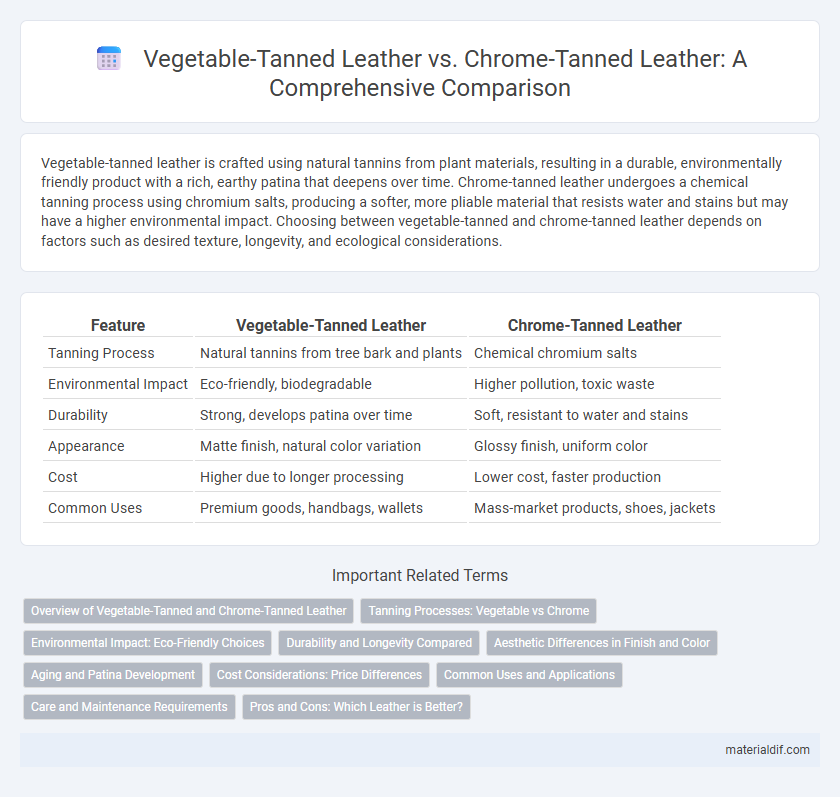Vegetable-tanned leather is crafted using natural tannins from plant materials, resulting in a durable, environmentally friendly product with a rich, earthy patina that deepens over time. Chrome-tanned leather undergoes a chemical tanning process using chromium salts, producing a softer, more pliable material that resists water and stains but may have a higher environmental impact. Choosing between vegetable-tanned and chrome-tanned leather depends on factors such as desired texture, longevity, and ecological considerations.
Table of Comparison
| Feature | Vegetable-Tanned Leather | Chrome-Tanned Leather |
|---|---|---|
| Tanning Process | Natural tannins from tree bark and plants | Chemical chromium salts |
| Environmental Impact | Eco-friendly, biodegradable | Higher pollution, toxic waste |
| Durability | Strong, develops patina over time | Soft, resistant to water and stains |
| Appearance | Matte finish, natural color variation | Glossy finish, uniform color |
| Cost | Higher due to longer processing | Lower cost, faster production |
| Common Uses | Premium goods, handbags, wallets | Mass-market products, shoes, jackets |
Overview of Vegetable-Tanned and Chrome-Tanned Leather
Vegetable-tanned leather is crafted using natural tannins from plant sources like tree bark, resulting in a durable, eco-friendly material with a rich, developing patina. Chrome-tanned leather undergoes a chemical tanning process using chromium salts, producing a softer, more supple leather that is water-resistant and quicker to produce. Both tanning methods significantly influence the leather's texture, longevity, environmental impact, and suitability for different products.
Tanning Processes: Vegetable vs Chrome
Vegetable-tanned leather undergoes a natural tanning process using tannins extracted from tree bark, leaves, and other plant materials, which results in a firmer, more durable, and environmentally friendly product. Chrome-tanned leather is treated with chromium salts, primarily chromium(III) sulfate, enabling a faster tanning process that produces softer, more pliable leather with higher water resistance. The vegetable tanning process typically takes several weeks, while chrome tanning can be completed in a few days, influencing the leather's texture, aging properties, and ecological footprint.
Environmental Impact: Eco-Friendly Choices
Vegetable-tanned leather is favored for its eco-friendly attributes, utilizing natural tannins from tree bark and leaves that reduce chemical pollution and biodegrade more easily. In contrast, chrome-tanned leather relies on synthetic chemicals like chromium salts, which pose significant environmental hazards through toxic waste and water contamination. Choosing vegetable-tanned leather supports sustainable practices and minimizes the ecological footprint of leather production.
Durability and Longevity Compared
Vegetable-tanned leather, crafted using natural tannins from tree bark and plants, offers exceptional durability and ages uniquely with a developing patina, making it highly resistant to wear and tear over time. Chrome-tanned leather, treated with chromium salts, provides superior water resistance and maintains softness and flexibility longer but can degrade faster under harsh environmental conditions. While vegetable-tanned leather excels in longevity and molds to usage patterns, chrome-tanned leather is favored for its immediate softness and color retention in high-moisture environments.
Aesthetic Differences in Finish and Color
Vegetable-tanned leather exhibits a rich, natural patina that deepens and warms over time, showcasing earthy tones and a matte finish that highlights the leather's organic texture. Chrome-tanned leather typically presents a more uniform, vibrant color with a glossy or semi-glossy surface, offering enhanced resistance to water and stains while maintaining a smooth, consistent finish. The distinct tanning methods result in varying aesthetics: vegetable tanning emphasizes natural irregularities and color evolution, whereas chrome tanning delivers bright, stable hues and a more polished appearance.
Aging and Patina Development
Vegetable-tanned leather develops a rich, natural patina over time, enhancing its aesthetic appeal and showcasing unique aging characteristics influenced by exposure to sunlight and moisture. Chrome-tanned leather, treated with chromium salts, offers greater colorfastness and resistance to wear but tends to retain its original appearance with minimal patina development. The slower aging process of vegetable-tanned leather results in deeper character and a more personalized look compared to the more uniform aging of chrome-tanned leather.
Cost Considerations: Price Differences
Vegetable-tanned leather typically costs more than chrome-tanned leather due to the lengthy, labor-intensive tanning process that uses natural tannins from plant sources. Chrome-tanned leather is generally more affordable because it involves faster processing with chromium salts, resulting in lower production costs. These price differences influence buyers prioritizing budget versus natural and environmentally friendly materials.
Common Uses and Applications
Vegetable-tanned leather is commonly used in high-quality leather goods such as saddles, belts, and wallets due to its durability and natural aesthetic that develops a rich patina over time. Chrome-tanned leather is preferred for mass-produced items like shoes, handbags, and upholstery because it is more flexible, water-resistant, and produced faster with a consistent finish. Both tanning processes influence the leather's suitability for specific applications based on factors like texture, color retention, and environmental impact.
Care and Maintenance Requirements
Vegetable-tanned leather requires regular conditioning with natural oils or waxes to maintain its moisture balance and prevent cracking, while chrome-tanned leather is more resistant to water and stains, needing less frequent maintenance. Avoid prolonged exposure to direct sunlight and moisture for vegetable-tanned leather to preserve its durability and patina development, whereas chrome-tanned leather benefits from occasional cleaning with mild soap and water. Proper storage in a cool, dry environment significantly extends the lifespan of both types, with vegetable-tanned leather demanding slightly more attentive care due to its organic tanning agents.
Pros and Cons: Which Leather is Better?
Vegetable-tanned leather offers durability, natural aging, and eco-friendliness due to its use of organic tannins, but it tends to be stiffer and more susceptible to water damage. Chrome-tanned leather is softer, more flexible, and resistant to moisture, making it ideal for fashion items, although it involves chemicals that raise environmental concerns. Choosing between vegetable-tanned and chrome-tanned leather depends on priorities like sustainability, texture, and intended use.
Vegetable-Tanned Leather vs Chrome-Tanned Leather Infographic

 materialdif.com
materialdif.com